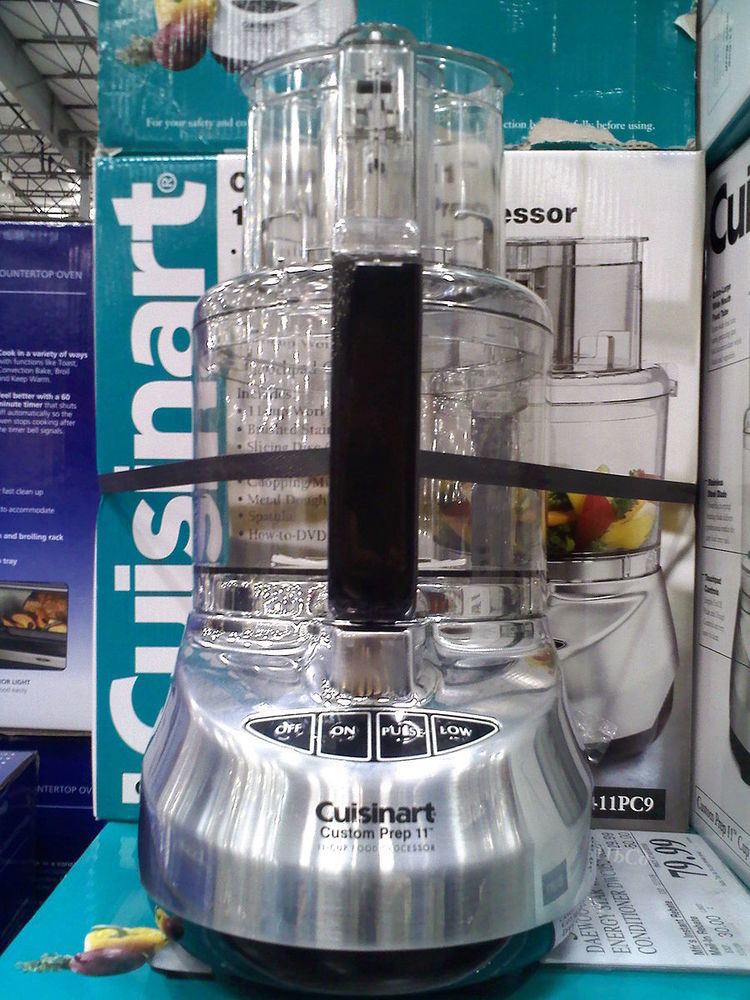 | ||
Cuisinart is an American home appliance brand owned by Conair Corporation. The company was started in 1971 by Carl Sontheimer to bring an electric food processor to the US market. The "Food Processor" was the first model, introduced at the National Housewares Exposition in Chicago in 1973 and released in Canada in 1975.
Contents
- Product lines
- Conception
- Introduction
- Competition
- Reception
- Legal troubles with Robot Coupe
- Product mix
- Sale to Conair
- References
In 1986, Cuisinart introduced a chopper/grinder (the Mini-Mate) and has since expanded to include a wide variety of products. Cuisinart became the property of Conair Corporation in 1989.
Product lines
A partial list of Cuisinart products includes:
Cuisinart products are available in upscale department and specialty stores nationwide.
Conception
The Cuisinart line was started by Carl Sontheimer and his wife Shirley Sontheimer. Carl Sontheimer trained at the Massachusetts Institute of Technology. He owned and operated Amzac Electronics, until he sold it in 1967. The idea of starting Cuisinart came from seeing a food preparation machine while traveling in France in 1971. His goal was to shorten the time spent doing repetitive tasks like cooking and baking. With this inspiration, he introduced the food processor to North America. With his engineering knowledge and passion for cooking, he decided to design similar technology for the American market. Sontheimer started by taking apart the prototype machine and making refinements to parts such as the feeding tube, cutting blade, and discs. In 1973 Sontheimer introduced "The Food Processor" at the "National Housewares Exposition in Chicago".
Introduction
Starting out, Sontheimer's device sold poorly. He tried marketing his food processor to department stores and grocery stores, but to the public it looked like nothing more than a high priced super blender. By 1975, culinary authorities such as James Beard, Julia Child, Craig Claiborne, Jacques Pepin and Helen McCully were using Cuisinart products publicly, causing a sharp rise in the popularity of the food processor. Their endorsements were noted in Gourmet magazine and The New York Times. Two years later in 1977, Cuisinart experienced a sharp rise in sales from a few units per month to several hundred. Cuisinart was first in the market that it created for itself. Eva Pomice, a writer for Forbes said that "With marketing savvy and a credible product, [the Sontheimers] were able to dominate the upper end of the food processor business against such top competitors as Moulinex and Robot-Coupe. Sontheimer did it by making the Cuisinart name synonymous with top quality and price." Company analyst concluded that Cuisinart graduated from selling a few food processors a month to about 150,000-250,000 in 1976. By 1977, Cuisinart's sales reached $50 million. Shortly (there?)after Cuisinart suspended the French company, Robot-Coupe, as its manufacturer and commissioned a Japanese company due to poor workmanship.
Competition
Around the time that Cuisinart's sales began to pick up, other kitchen manufacturers entered the market, such as Hamilton Beach Brands, Sunbeam Products, and KitchenAid. By the end of that year, there were more than 30 food processors from a variety of different brands to select from. Prices typically ranged from $30 to $400.
Reception
Although professional chefs were familiar with some food preparation machines, food processors were then unheard of. The device was almost unknown before it was debuted in Chicago. Sontheimer picked a propitious time to introduce American consumers to the food processor. During the 1970s women began to experiment with more difficult recipes at home, and their interest in kitchen gadgets was peaking.
Legal troubles with Robot-Coupe
Since the Robot-Coupe company no longer distributed Cuisinart's food processors, it launched a product of its own in 1978. The French company designed U.S ads that read "It used to be pronounced Cuisinart". Promotional battles spilled over into the 1980s. After battling via slanderous advertisements, a lawsuit ensued, and Robot-Coupe was ordered to stop insinuating Cuisinart sold products manufactured by Robot-Coupe.
Product mix
Regardless of legal troubles, Cuisinart introduced six new products by 1982. These new products had bigger blades, more attachments, and more features. One of the six models sold for $600 retail price. Expanding the diversity of food processor products was Cuisinart's way of creating variety within their market. Critics felt that this wasn't the kind of diversity they needed, that Cuisinart needed to look outside of the world of food processors, and begin broadening their marketplace there. Kerry Hannon, a writer for Forbes commented that "Sontheimer's market blindness ... kept him from capitalizing on the quality of image that the Cuisinart name conveyed. He introduced a line of high-priced cookware into a jam-packed and fading market. But more natural line extensions like blenders, for example, eluded him."
Sale to Conair
By 1988, Cuisinart had established itself as a premier North American houseware brand; the introduction of the Mini-Mate chopper-grinder (the first Cuisinart product that was not a food-processor) helped maintain that position. In 1989, the Sontheimers sold the company to a group of investors for $60 million. The company was eventually renamed to 'Cuisinart, Inc' and sold again, this time to Conair Corporation in 1989. Cuisinart remains a Conair brand to this day.
